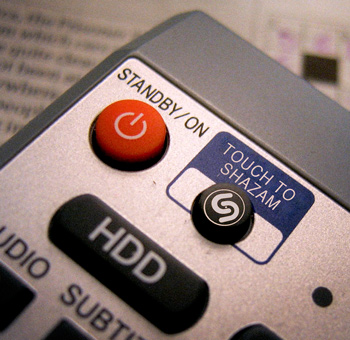Shazam's future involves applying its discovery engine to television and all of the brands that flow through it, says CEO Andrew Fisher. And it could be as simple as a button on your channel flipper.
 Shazam, the app that scans and identifies audio clips, has dominated the music landscape, enabling users to hold up their smartphones to speakers and let Shazam name that tune. But the startup's future is in television, says CEO Andrew Fisher, part of the company's attempt to capture the "second-screen experience," a market broadcasters and advertisers are yearning to own in order to boost engagement as more and more viewers open up iPads and iPhones alongside their TVs.
Shazam, the app that scans and identifies audio clips, has dominated the music landscape, enabling users to hold up their smartphones to speakers and let Shazam name that tune. But the startup's future is in television, says CEO Andrew Fisher, part of the company's attempt to capture the "second-screen experience," a market broadcasters and advertisers are yearning to own in order to boost engagement as more and more viewers open up iPads and iPhones alongside their TVs.
Shazam has already partnered with big-name networks including HBO and MTV and with big-brand advertisers such as Old Navy and P&G. But it's far from the only player in the space, as everyone from Twitter and Yahoo to Peel and GetGlue look to gain a foothold in the market. Fisher believes "very few" of these players will survive. "It's too fragmented," he says. "There's a lot of activity in the second-screen startup space, but the challenge for them is that these are really applications without users." Not Shazam. Fisher says more than 53 million North American households have the app installed on a device--and his company is looking to expand that reach. Should we expect a Shazam button to start showing up on traditional TV remote controls?
"Um ... I can't answer that question," Fisher says with hesitation. "I mean, yes. We want to be pervasive, and we're looking at consumer electronics devices. A lot of manufacturers of consumer electronic devices have approached us about building Shazam in. We think there's real opportunity down the line in the connected TV experience, so we're very interested in the space."
The opportunity, of course, is huge for whoever can win the second-screen industry. Advertisers and broadcasters are clamoring to grab more viewer attention on mobile devices. "The broadcasters really want to drive ideally real-time check-ins to their shows, meaning they don't want people to DVR; they don't want people to fast-forward through the adverts; they want them to be engaged watching the show, and ideally sit through the ad break as well," Fisher says. "And the advertisers recognize that with more device adoption, there are more opportunities now to extend their engagement with the audience."
With more than 175 million global downloads of the app and a fresh round of $32 million in capital, Shazam believes the space is theirs to lose. Advertisers are starting to feel comfortable featuring Shazam's logo in advertisements; when a user "Shazams" a commercial on a mobile device, marketers have the opportunity to promote social content, coupons, products, and so forth on smartphones and tablets. Old Navy recently ran a $21 million campaign with Shazam, and according to Fisher, saw that 27% of consumers who "Shazam'd" the advert went onto "shop the look," meaning either they looked at clothing featured in the ad or redeemed a promotion in the company's online store. That success has advertisers foaming at the mouth--it's estimated now that Shazam could power up to a third of Super Bowl ads this February.
The issue is the time it takes to actually Shazam a commercial. The experience now feels almost like a pathetically slow gunslinger's duel. When an advertisement first shows up with the Shazam logo, a user has to register that the ad is Shazam-enabled; next, pull out a smartphone, unlock the device, scroll over the Shazam app, open it up, and then hit the Shazam button, a scanning process that can take a bit of time to complete. That's a lot of action to fit into a commercial, especially if it's only for a 15-second spot.
Fisher is well aware of the potential problem. That's why Shazam's engineers, he says, are working toward building a "sub-five second experience, so it's super quick." Adding a Shazam button to TV remote controls could be one way Fisher solves the issue, enabling quick access to Shazam-able content whether from broadcasters or brands.
Still, Fisher wants to perfect the mobile, second-screen experience.
"There are more and more homes now where everyone in the family has a cellphone. So someone may want to vote [while watching a show], someone else may want to tweet or Facebook, and someone else may want to see behind-the-scenes footage," he says. "We think connected TVs are important, but we believe we will win through cellphones. Ultimately it's about the personalized experience."
[Source Image: Flickr user Danny McL]